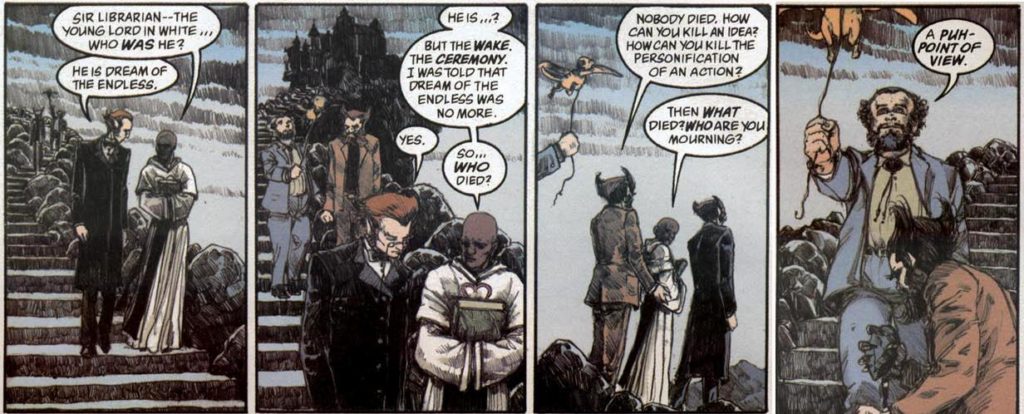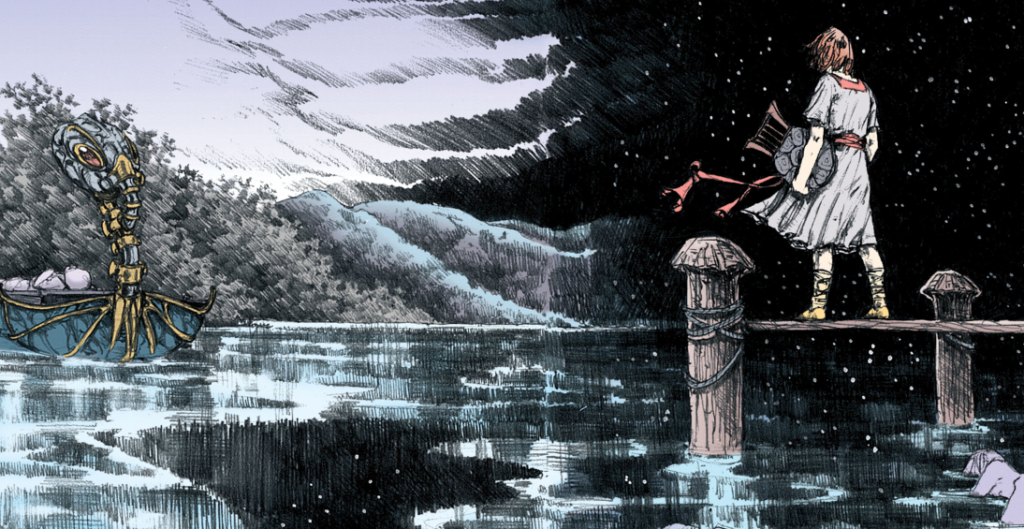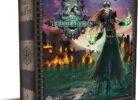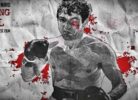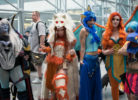Eight years ago, Stephen Segal, then creative director at the legendary Weird Tales magazine, asked if he could use some modest writings I had been doing on Neil Gaiman’s Sandman for a 20th anniversary retrospective he was putting together. Naturally, I said yes. Sadly, the series was lost in a website revamp. Not wanting it to disappear into the ether, I’m now presenting it on my site in 11 parts (alas, without the benefit of Stephen’s editing; these are pre-publication versions). Hope you enjoy.
Recurring Dream: An Anniversary Re-reading of Neil Gaiman’s Sandman
Part 11 of 11, The Wake
Originally published on the Weird Tales website, January 2009
 What is a wake but a time to remember and reflect? A wake is an ending. A closing of a chapter. It is also the start of a new chapter, the beginning of a time without the person being honored. Of a life without them in it.
What is a wake but a time to remember and reflect? A wake is an ending. A closing of a chapter. It is also the start of a new chapter, the beginning of a time without the person being honored. Of a life without them in it.
This is The Wake, the final chapter of the core Sandman narrative. A look back at who and what Dream was, the people and beings he came in contact with, and a glimpse ahead at a world without the Dream we knew. In death, Sandman is brought to life by the lushest art of the series, richly drawn and highlighted with washed out colors that look as if the life has been bled out of the vibrant and colorful world we just left.
It’s not an action-packed arc. It’s not a particularly dramatic arc. It’s an epilogue. A reflection. We rotate through characters quickly, getting their thoughts and observations as they remember the Dream who has passed and welcome the Dream who has arrived. We even catch vague glimpses of DC Comics icons like Superman, Batman, Martian Manhunter and Darkseid. Gaiman distanced himself from the mainstream comic universe, so we’re quick to forget that Sandman is part of it, but these serve as a reminder that Dream was part of a much larger tapestry. The heart of these sequences is Matthew the raven, the human element in a very supernatural setting. He’s not happy about welcoming the new Dream. He does not want to accept him as his master. Most others take it as a matter of course, as the natural changing of the guard, but to Matthew it feels wrong, as if Dream’s memory is somehow being tarnished by embracing this new personification.
Even the new Dream is unsure of his place in the order of things. He shows flashes of confidence (notably untainted by the arrogance of the previous Dream), yet he’s awkward and hesitant at times, especially when it comes to dealing with his siblings, the Endless. He will need time to grow into his role.
This is, after all, just as much a beginning as it is an end.
It’s a wonderfully somber set of stories that may be too lacking in happenings for some, but to me was a perfect way to spend just a little more time with these characters before they’re gone. It’s not unlike the extended coda of J.R.R. Tolkien’s The Lord of the Rings in that respect. The Ring is destroyed, Aragorn is crowned King of Gondor, and yet we’ve still got 100 pages of goodbyes and farewells and so longs to go.
We, the reader, don’t want to leave. And clearly neither does the author.
The Michael Zulli-illustrated arc finishes with one last visit with Gadling (or Hob), Dream’s undying human friend. During a trip to a Renaissance Fair, Gadling complains about the lack of realism and complete misrepresentation of the past displayed at the fair. He drinks and complains some more, dwelling on what was. When confronted by Death, he’s given a chance to finally close the door on his life. Ultimately, he chooses not to, instead deciding to embrace what is ahead rather than what lay behind. It’s as if Gaiman is telling us not to look back and mourn the end of the series, not to think about what was, but rather to look ahead and see the potential of the blank slate. To think about what could be.
Two one-shot stories close things out. “Exiles” is a fine enough journey back to the “soft places” between dreams, something of a sequel to an earlier short story. Some might question why this story is here. It doesn’t do or reveal much after all, and has little connection to the overall narrative. All this is quite true and valid. It does seem kind of out of place. If there is a message to be taken from it, though, it’s woven into the story subtly. Here Dream is dead, yet Dream still lives in the soft places between stories and dreams and reality. He is both alive and dead. Living and gone.
The message is simple: The Sandman story may be over, but these characters still exist somewhere. They still linger in places unconnected to the “real,” and maybe, if the wind blows right or our paths lead us off the expected road, we might encounter them again some day. (And we did, first with Sandman: The Dream Hunters and then with Sandman: Endless Nights).
The final tale returns us to William Shakespeare, who is struggling through his final play, The Tempest. It is the second of two plays commissioned by Dream, and Dream is awaiting his payment. Shakespeare struggles with the story, the characters, his approach.
It’s one last look at stories. Storytelling. And storytellers.
And then the door is closed.
And Sandman is no more.
But stories? Stories are forever.

